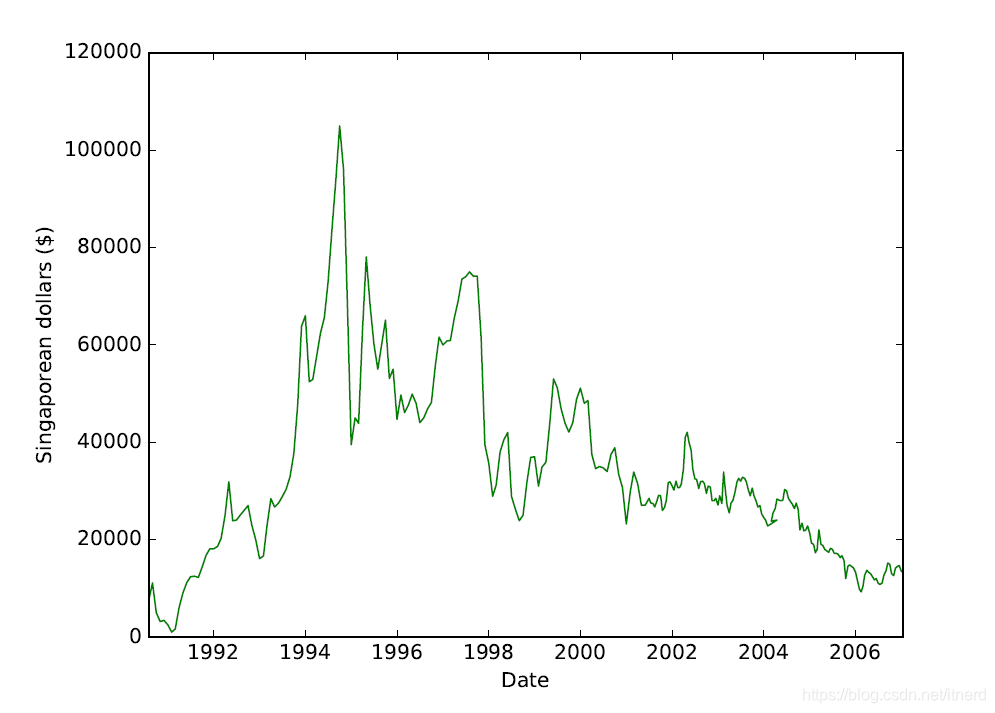python 时间序列预测——简单神经网络
时间序列生成
y t = α + β y t − 1 + ϵ t y_t = \alpha + \beta y_{t-1} + \epsilon_t yt=α+βyt−1+ϵt
seed =2019
np.random.seed(seed)
y_0 = 1
alpha = -0.25
beta = 0.95
y=pd.Series(y_0)
num =1000
for i in range(num):
y_t = alpha +(beta * y_0)+ np.random.uniform(-1, 1)
y[i]=y_t
y_0 = y_t
plt.plot(y)
plt.show()

数据集下载
Certificate of Entitlement Price :
If you have lived in Singapore, you will know that anyone who wants to
register a new vehicle must first obtain a Certificate of Entitlement
(COE). It gives the holder the right to vehicle ownership and access
to the very limited road space in the tropical island city-state. The
number of COEs issued is limited and they can only be obtained through
an open bidding system.

url ="http://ww2.amstat.org/publications/jse/datasets/COE.xls"
loc = "./COE.xls"
request.urlretrieve(url,loc)
Excel_file = pd.ExcelFile (loc)
print(Excel_file . sheet_names)
'''
['COE data']
'''
spreadsheet = Excel_file.parse ('COE data')
print(spreadsheet.info())
'''
<class 'pandas.core.frame.DataFrame'>
RangeIndex: 265 entries, 0 to 264
Data columns (total 6 columns):
DATE 265 non-null datetime64[ns]
COE$ 265 non-null float64
COE$_1 265 non-null float64
#Bids 265 non-null int64
Quota 265 non-null int64
Open? 265 non-null int64
dtypes: datetime64[ns](1), float64(2), int64(3)
memory usage: 12.5 KB
None
'''
data = spreadsheet ['COE$']
print(data . head ())
'''
0 7400.0
1 11100.0
2 5002.0
3 3170.0
4 3410.0
Name: COE$, dtype: float64
'''
print ( spreadsheet ['DATE'][193:204])
'''
193 2004-02-01
194 2002-02-15
195 2004-03-01
196 2004-03-15
197 2004-04-01
198 2002-04-15
199 2004-05-01
200 2004-05-15
201 2004-06-01
202 2002-06-15
203 2004-07-01
Name: DATE, dtype: datetime64[ns]
'''
修正数据错误并保存
spreadsheet.at[194,'DATE']='20040215'
spreadsheet.at[198,'DATE']='20040415'
spreadsheet.at[202,'DATE']='20040615'
loc = "COE.csv"
spreadsheet.to_csv(loc)
一、单纯基于历史做预测
数据归一化
x= data
scaler = preprocessing.MinMaxScaler(feature_range=(0,1))
print(scaler)
'''
MinMaxScaler(copy=True, feature_range=(0, 1))
'''
x = np.array(x).reshape((len(x),)) # shape (265,)
x = np.log(x)
x = x.reshape(-1 ,1) # shape (256,1)
x = scaler.fit_transform(x)
x = x.reshape(-1) # shape (265,)
print(round(x.min () ,2),round(x.max () ,2))
'''
0.0 1.0
'''
Partial AutoCorrelation Function
from statsmodels.tsa.stattools import pacf
x_pacf = pacf(x ,nlags=50, method='ols')
plt.plot(x_pacf)

TimeSeriesNnet 类
logging.basicConfig(format='%(levelname)s:%(message)s', level=logging.INFO)
class TimeSeriesNnet(object):
def __init__(self, hidden_layers = [20, 15, 5], activation_functions = ['relu', 'relu', 'relu'],
optimizer = SGD(), loss = 'mean_absolute_error'):
self.hidden_layers = hidden_layers
self.activation_functions = activation_functions
self.optimizer = optimizer
self.loss = loss
if len(self.hidden_layers) != len(self.activation_functions):
raise Exception("hidden_layers size must match activation_functions size")
def fit(self, timeseries, lag = 7, epochs = 10000, verbose = 0):
self.timeseries = np.array(timeseries, dtype = "float64") # Apply log transformation por variance stationarity
self.lag = lag
self.n = len(timeseries)
if self.lag >= self.n:
raise ValueError("Lag is higher than length of the timeseries")
self.X = np.zeros((self.n - self.lag, self.lag), dtype = "float64")
self.y = np.log(self.timeseries[self.lag:])
self.epochs = epochs
self.scaler = StandardScaler()
self.verbose = verbose
logging.info("Building regressor matrix")
# Building X matrix
for i in range(0, self.n - lag):
self.X[i, :] = self.timeseries[range(i, i + lag)]
logging.info("Scaling data")
self.scaler.fit(self.X)
self.X = self.scaler.transform(self.X)
logging.info("Checking network consistency")
# Neural net architecture
self.nn = Sequential()
self.nn.add(Dense(self.hidden_layers[0], input_shape = (self.X.shape[1],)))
self.nn.add(Activation(self.activation_functions[0]))
for layer_size, activation_function in zip(self.hidden_layers[1:],self.activation_functions[1:]):
self.nn.add(Dense(layer_size))
self.nn.add(Activation(activation_function))
# Add final node
self.nn.add(Dense(1))
self.nn.add(Activation('linear'))
self.nn.compile(loss = self.loss, optimizer = self.optimizer)
logging.info("Training neural net")
# Train neural net
self.nn.fit(self.X, self.y, epochs = self.epochs, verbose = self.verbose)
def predict_ahead(self, n_ahead = 1):
# Store predictions and predict iteratively
self.predictions = np.zeros(n_ahead)
for i in range(n_ahead):
self.current_x = self.timeseries[-self.lag:]
self.current_x = self.current_x.reshape((1, self.lag))
self.current_x = self.scaler.transform(self.current_x)
self.next_pred = self.nn.predict(self.current_x)
self.predictions[i] = np.exp(self.next_pred[0, 0])
self.timeseries = np.concatenate((self.timeseries, np.exp(self.next_pred[0,:])), axis = 0)
return self.predictions
训练

count = 0
ahead = 12
pred = []
while ( count < ahead ) :
end =len(x) - ahead + count
np.random.seed(2016)
model = TimeSeriesNnet(hidden_layers =[ 7 , 3 ], activation_functions = ["tanh" , "tanh"])
model .fit ( x[ 0 : end ] , lag = 1 , epochs = 100)
out = model.predict_ahead(n_ahead = 1)
print ("Obs: " , count+1, "x =" ,round( x[count] , 4 ) , "prediction = " , round(pd.Series(out) , 4 ) )
pred.append(out)
count = count + 1
pred = np.exp(scaler.inverse_transform(pred))
target = np.exp(scaler.inverse_transform(x[-ahead:].reshape(-1,1)))
plt.plot(target)
plt.plot(pred1)
plt.legend(['target','prediction'])

二、同时基于历史和外部输入来预测
输入为 x x x,输出为 y y y
此时的输入不仅包含上一时刻的 y,还包含另外3个时间序列的值
loc= "COE.csv "
temp = pd.read_csv ( loc )
data= temp . drop ( temp . columns [ [ 0 , 1 ] ] , axis=1)
y=data ['COE$']
x=data.drop ( data . columns [ [ 0 , 4 ] ] , axis =1)
x=x.apply(np.log )
x=pd.concat ( [ x , data ['Open?' ] ] , axis=1)
print(x.head())
'''
COE$_1 #Bids Quota Open?
0 8.955448 6.486161 6.156979 0
1 8.909235 7.287561 6.148468 0
2 9.314700 6.450470 6.156979 0
3 8.517593 6.858565 6.236370 0
4 8.061487 6.823286 6.154858 0
'''
scaler_x = preprocessing . MinMaxScaler (feature_range=(0 , 1))
x = np.array(x).reshape((len (x) , 4))
x = scaler_x.fit_transform (x)
scaler_y = preprocessing . MinMaxScaler (feature_range=(0 , 1) )
y = np.array(y).reshape((len (y) , 1))
y = np.log(y)
y = scaler_y.fit_transform(y)
y=y.tolist ( )
x=x.tolist ( )
使用 pyneurgen 库
from pyneurgen . neuralnet import NeuralNet
random. seed(2019)
nnet = NeuralNet ( )
nnet.init_layers ( 4 , [ 7 , 3 ] , 1)
nnet.randomize_network()
nnet . set_learnrate ( .05 )
nnet . set_all_inputs ( x )
nnet . set_all_targets ( y )
length = len ( x )
learn_end_point = int ( length * 0.95 )
nnet . set_learn_range ( 0 , learn_end_point )
nnet . set_test_range ( learn_end_point + 1 ,length -1)
nnet . layers [ 1 ] . set_activation_type ( 'tanh' )
nnet . layers [ 2 ] . set_activation_type ( 'tanh')
nnet . learn ( epochs=100 ,show_epoch_results=True ,random_testing=False )
mse = nnet . test ( )
print (" test MSE =" ,np . round(mse , 6 ))
result = np.round( nnet.test_targets_activations , 4 )
plt.plot(result[:,0])
plt.plot(result[:,1])
plt.plot(result[:,0]*1.05,'--g',result[:,0]*0.95,'--g')
plt.legend(['target','prediction','comfort interval'])

